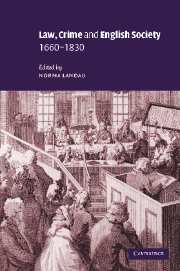Book contents
- Frontmatter
- Contents
- List of figures
- Notes of contributors
- 1 Introduction
- Part 1 Law
- Part 2 Crime
- 5 War as a judicial resource. Press gangs and prosecution rates, 1740–1830
- 6 Making the ‘bloody code’? Forgery legislation in eighteenth-century England
- 7 Mapping criminal law: Blackstone and the categories of English jurisprudence
- Part 3 Society
- John M. Beattie's publications
- Index
6 - Making the ‘bloody code’? Forgery legislation in eighteenth-century England
from Part 2 - Crime
Published online by Cambridge University Press: 30 June 2009
- Frontmatter
- Contents
- List of figures
- Notes of contributors
- 1 Introduction
- Part 1 Law
- Part 2 Crime
- 5 War as a judicial resource. Press gangs and prosecution rates, 1740–1830
- 6 Making the ‘bloody code’? Forgery legislation in eighteenth-century England
- 7 Mapping criminal law: Blackstone and the categories of English jurisprudence
- Part 3 Society
- John M. Beattie's publications
- Index
Summary
The proponents of legal reform in early nineteenth-century Britain developed a critique of the existing criminal law whose appeal was as much emotional as it was intellectual. The prominent place of the gallows in English justice struck them as morally repugnant. They resorted to a highly charged language in which to express their revulsion. William Wilberforce, in 1819, bemoaned the fact that the nation had been saddled with what he called ‘that code of blood’. He meant by this phrase the many statutes that imposed the death penalty for a staggering range of offences. The law, he said, breathed a vindictive spirit. It was at odds with the humane sentiments that represented the true feelings of the English people. So long as the code continued to exist, it would cause anguish to the benevolent, while brutalizing the less civilized portions of the community. The operation of justice, the reformers argued, was perverted by this steady reliance upon death. Piecemeal change would not remedy an institution so fatally flawed. Nothing less than a fundamental transformation of the law would rescue the reputation of the nation.
The advocates of change justified their portrait of the law by appealing to a variety of arguments. They offered examples of the inconsistencies between various capital statutes, and they pointed to the seemingly trivial nature of the offences, as proof of the ills that afflicted the code.
- Type
- Chapter
- Information
- Law, Crime and English Society, 1660–1830 , pp. 117 - 138Publisher: Cambridge University PressPrint publication year: 2002
- 5
- Cited by



